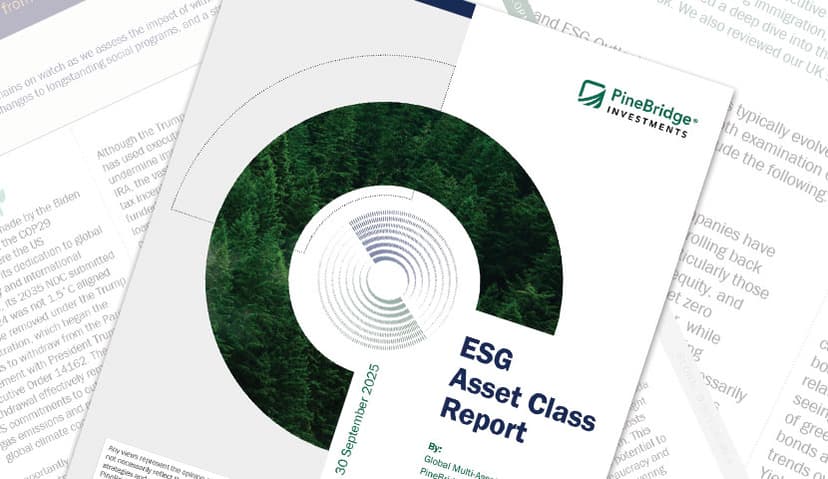PineBridge Investments held its fourth annual ESG Forum in May 2024, featuring sessions with both in-house and external experts focused on educating our employees and advancing progress across key environmental, social, and governance (ESG) factors that are integral to our investment processes. This year’s forum emphasized progress in engagement across our investment strategies, along with sessions devoted to environmental policy and sustainable investment developments.
A keynote discussion between PineBridge CEO Greg Ehret and Environmental Defense Fund President Fred Krupp focused on the economics of policy decisions related to the environment. The conversation examined a wide range of related issues with an organization that approaches environmental and stewardship concerns from a different perspective than an investment firm.
As environmental issues, particularly climate change, have grown in importance over recent years, capital markets have evolved to reflect those concerns. One clear example is the explosion in issuance of green bonds and more recently, sustainability bonds. (While green bond proceeds are dedicated to specific uses, sustainability bonds can be used for general corporate purposes.) Green bonds’ total outstanding amount is now around $5 trillion, with around $600 billion in new issuance in 2023 versus just under $200 billion in new issuance in 2018. Sustainability bonds went from near-zero in 2018 to $70 billion in new issuance in 2023, according to Bloomberg and Climate Bonds Initiative, as of May 2024.
An engagement panel featuring senior members of PineBridge’s investment platform reflected on the evolution of ESG approaches, highlighting the transition from exclusionary practices, to the strategy we employ as a firm which focuses on improvement over exclusion. It combines active investing and active engagement with companies to help them become better stewards of the planet as well as stronger financial players with more robust investment returns.
As Steve Hasnain, Portfolio Manager, US CLO Management, Co-Director of Leveraged Finance Research, said, “I think for many companies, ‘ESG’ had the connotation of exclusion, and investing decisions being made for noneconomic reasons. But under an engagement approach versus exclusionary approach, companies tend to see their financing costs decrease when they implement better practices, and this helps raise the value of the securities we hold.”
Indeed, according to Michael Kelly, Global Head of Multi-Asset, “Our engagement process identifies companies we believe can benefit from consistent improvement of ESG metrics, which in turn seek to benefit our portfolio risk and return.” Mack Fuller, Senior Portfolio Manager & Head of Sustainable Investing, Private Credit, explained how this works for the lower middle market companies his team focuses on: “Our approach to assessing the progress of our portfolio companies from an ESG perspective follows a similar process to how our team analyzes credit fundamentals. We’re looking to evaluate how - and in the long run, encourage our companies to exercise good corporate citizenship. Our approach is to be iterative, be progressive, and continue to strengthen our partnership.”
Of course, what’s desirable in a “sustainable” investment differs depending on who’s making the investment and where. In a panel discussing sustainable investing trends, Kay Hope, Head of Fixed Income ESG Research, Bank of America Merrill Lynch, noted that Bank of America conducts several annual surveys on the topic and has so far found a greater takeup of ESG-focused investment in Europe than in the US, noting that in Europe, close to 40% of high yield investors say their investment decisions must adhere to strong ESG guidelines. Hope added that in addition to survey results, when her team talks with investors, they find:
“[Fixed income] investors both in the US and Europe tend to think about sustainability for two reasons. One is that their end investors are pushing them in this direction, and the other is for risk mitigation. That actually makes it quite different, for instance, from why equity investors might look at sustainability. When we speak to equity investors, they're more likely to say that they look at sustainability for additional alpha, whereas for us, it's really about avoiding risk.”
As Ronald Harling, Credit Analyst, Developed Markets Investment Grade, explained in the engagement panel, with either green bonds or sustainability bonds, investors’ intended outcome is the same: improving the issuer’s environmental metrics. Issuers tend to benefit financially, perhaps seeing a 5 bps to 15 bps improvement in a coupon, which is significant in the corporate investment grade universe, where spreads are already fairly tight. “Ultimately, it's down to the market to decide how much benefit companies will earn - what we call the ‘greenium’” Harling said. “I believe this market will continue to grow, precisely because of the beneficial economics.”


